


The TRACE images may be used without restrictions
in publications of any kind. We
appreciate an acknowledgement indicating that
the Transition Region and Coronal Explorer, TRACE,
is a mission of the Stanford-Lockheed Institute for Space
Research, and part of the NASA Small Explorer program. More information on
TRACE and other TRACE images can be found
here.

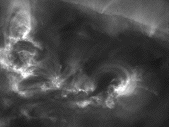 |
This
QT movie (5MB) shows
the activation of a small filament in AR10785, observed by TRACE in
its 195Å channel on May 3, 2006. The movie shows the
evolution from 22:30 UT through 00:22 UT the next day. At the start
of the movie, the filament configuration under the loop arcade
activates, and ejects matter towards the right (the images were rotated
90 degrees counterclockwise, so the ejection is towards the south),
without affecting the overlying arcade. Then, after TRACE comes out
from behind the Earth's atmosphere (reflected in the dimming of the
images by Earth-atmospheric absorption) matter can be seen
streaming back from outside the field of view (here cut to 640x480
pixels of 375km each). Notice the brief lighting up of lower
loops in the arcade around frame 65 (23:45 UT): these appear
more strongly sheared than the higher loops, as expected for a
filament configuration. Event pointed out by Dawn Myers (GSFC).
 |
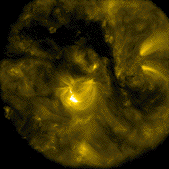 |
On 16 June 2006, TRACE observed a small, unnumbered active region
near the center of the solar disk. This image, taken in the 171Å
channel (most sensitive to emission from gases at one million degrees)
shows that region near the center of the 1024x1024 pixel field of
view (with 725km/pixel). The region's most impressive neighbor is a
large, dark filament whose 'cool' gases (at 20,000K or below) do not
emit in the EUV light seen by TRACE, and in fact block that light if
any hot material would lie below it.
 |
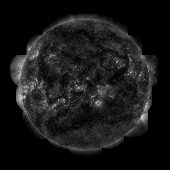 |
The big picture IIITRACE's field of view covers only a fraction of the entire Sun, but by repeatedly repointing, it can create an image of the entire solar corona. This image shows the solar corona on 2001/02/19 in the 171Å channel (most sensitive to emission from 1 million degree gases).The image (rescaled to 1500 by 1500 pixels to a side) shows a rather inactive corona. Notice, in particular, the very long filament channel that runs from one side of the disk to the other. Compare that to the Big-Bear H alpha image which shows that the filament channel is much more extended and complete than the filaments that sit within it. P.S. There is also a 4.6MB
4500x4500 pixel version of this image.
For those interested in an annotated list of all 3EUV mosaics
made by TRACE prior to 2006, click here.
|
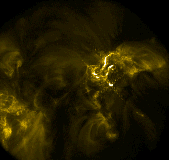 |
On April 27, 2006 at 15:52 UT TRACE observed a GOES-class M7.9 flare
in 195. AR 10875 has given us a short respite from solar minimum. The
beta-gamma-delta configuration has produced several C-class and
2M-class flares in the span of 2 days.This
movie (1MB) shows
the evolution of the flare from 15:15 UT to 16:30 UT (scaled down
by a factor of two in size). Notice the strong flare ribbons and
the embedded bright points, causing strong diffraction patterns
(as in the image to the left, taken at 15:47:22 UT). Movie courtesy
of LiWei Lin and Trish Jibben (SAO).
 |
 |
In the late phases of the coronal evolution following a C2.6 flare
in AR10875, observed by TRACE in its 195Å pass band, this
interesting magnetic configuration developed (seen here rotated by
90 degrees clockwise): just above the center of the image, two arcades
of loops come together, with sharply bent field lines near the top.
Such a configuration suggests the presence of a magnetic null or X point
at the top of the two arcades on a separatrix running between the arcades.
TRACE frequently observes such cusps, all appearing and fading from view
in individual loops quite rapidly, but with new loops often forming
to indicate the longevity of the magnetic topopology even if the
individual loops are ephemeral.
 |
 |
This image is one snapshot from a
movie (QuickTime,
JPEG compressed, 6.2MB) of observations of Active Region 10872 taken
on 2006 April 19, from 17 UT through 24 UT, in the 171Å channel
of TRACE. The image sequence has not been aligned as we normally do, but
shows the Sun rotating under the fixed pointing of TRACE, and one repointing
well into the movie. Notice the streaming or waves propagating through the
cool loop fans, particularly in the trailing, northern section of the
region. Halfway through the movie, a small eruption occurs underneath
the leading loops, much like a filament destabilization, although no
filament is visible in these observations. Courtesy Dawn Myers (GSFC).
 |
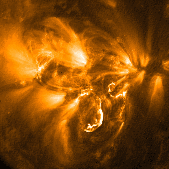 |
On April 11, 2006, TRACE observed a C2 flare in Active Region 10871. This
image, taken at 18:22UT in the 171Å channel, shows the flare in
progress. South of the center of the image is an arced bright flare
'ribbon'; the brightest, southernmost extension of it coincides with
a small, unstable filament that is visible in the images following this one.
The matching second flare ribbon is much weaker, and placed highly
asymmetrically relative to the filament, seen to the left/west of the
brighter ribbon. That ribbon moves rapidly over weaker field, in parts
revealing structures like fibrils commonly seen in Halpha images.
Image courtesy of Dawn Myers, GSFC.
 |
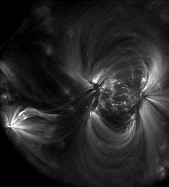 |
This 7.2MB QuickTime movie
shows ghoulish plasma motions on the Sun within
Active Region 10865 (center right) observed by TRACE in its 171Å channel
(April 4, 2006 4:30-5:30 UT). But, as if trying to steal our attention,
sister region AR 10867 (whose eastern edge juts into the lower left of
the field of view - here shown at half size)
interjects with a demonic display of its own. Midway
through this clip, AR 10867 spews a bulk of plasma along interconnecting
field lines in the general direction of its larger, more photogenic
sibling, demonstrating once again the ongoing complex interplay of plasma
and magnetic fields in the solar corona. [Entry courtesy of LiWei Lin, SAO]
 |
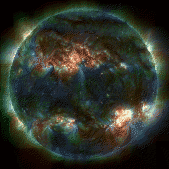 |
The big picture IITRACE's field of view covers only a fraction of the entire Sun, but by repeatedly repointing, it can create an image of the entire solar corona. This image shows the solar corona on 1999/08/02 in a false-color, 3-layer composite: the blue, green, and red channels show the 171Å, 195Å, and 284Å, respectively (most sensitive to emission from 1, 1.5, and 2 million degree gases).The image (rescaled to 1500 by 1500 pixels to a side) shows the corona for a moderately active Sun, with some (red) hot active regions in both hemispheres, surrounded by the (blue/green) cooler plasma of the quiet-Sun corona. Notice the multitude of relatively cool loops connecting the active regions on both hemispheres. P.S. There is also a 7.4MB
4500x4500 pixel version of this image.
For those interested in an annotated list of all 3EUV mosaics
made by TRACE prior to 2006, click here.
|
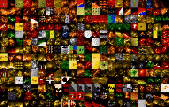 |
TRACE's 8th birthday: 2006 April 2
TRACE, launched on 1998 April 2, continues to provide unparalleled
images of the Sun, working tirelessly after 17.7 million exposures!
This collage is a composite images used earlier on these TRACEpod
pages. We have logged over 600 publications in the refereed professional
literature (listed here) that are based directly or indirectly on TRACE
observations. A few more TRACE images, and a story on the explosive
solar corona, can be found in the April 2006 issue of
Sky and Telescope
(cover page).
2200x1400 pixel collage;
1100x700 pixel collage;
html composite (resizable for layout).
|
|
| Home | Mission | Instrument | Team | Operations | Results | Images | Movies | Education | Site Info. | |